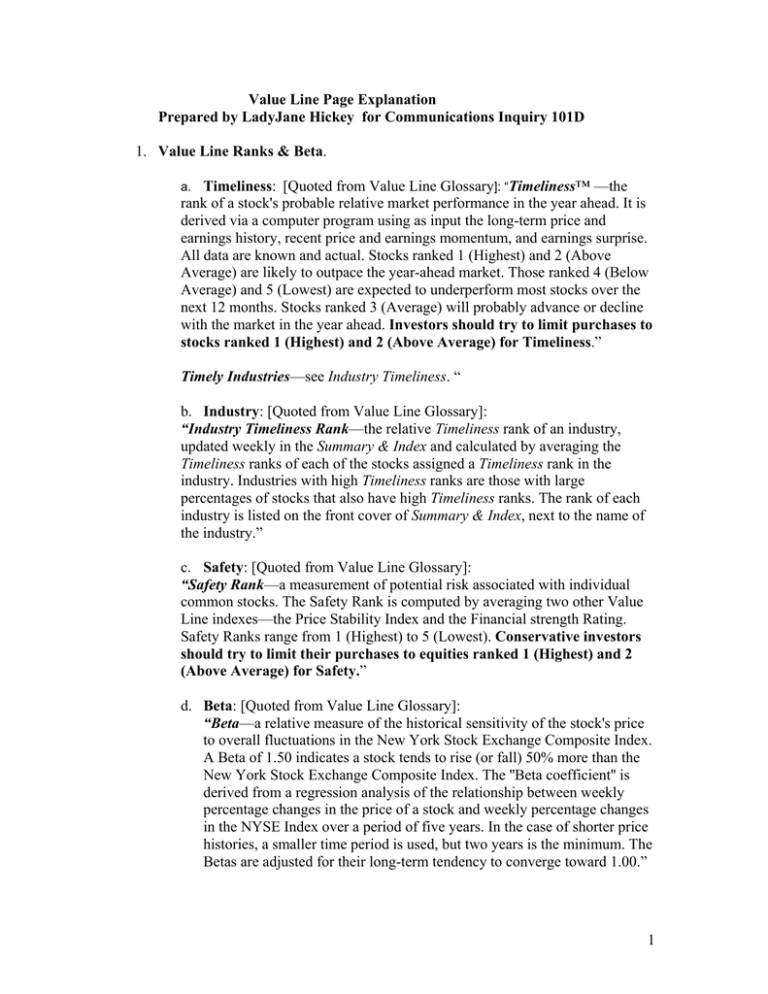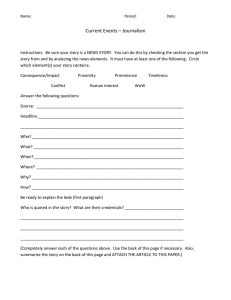Value Line Page Explanation
advertisement

Value Line Page Explanation Prepared by LadyJane Hickey for Communications Inquiry 101D 1. Value Line Ranks & Beta. a. Timeliness: [Quoted from Value Line Glossary]: “Timeliness™ —the rank of a stock's probable relative market performance in the year ahead. It is derived via a computer program using as input the long-term price and earnings history, recent price and earnings momentum, and earnings surprise. All data are known and actual. Stocks ranked 1 (Highest) and 2 (Above Average) are likely to outpace the year-ahead market. Those ranked 4 (Below Average) and 5 (Lowest) are expected to underperform most stocks over the next 12 months. Stocks ranked 3 (Average) will probably advance or decline with the market in the year ahead. Investors should try to limit purchases to stocks ranked 1 (Highest) and 2 (Above Average) for Timeliness.” Timely Industries—see Industry Timeliness. “ b. Industry: [Quoted from Value Line Glossary]: “Industry Timeliness Rank—the relative Timeliness rank of an industry, updated weekly in the Summary & Index and calculated by averaging the Timeliness ranks of each of the stocks assigned a Timeliness rank in the industry. Industries with high Timeliness ranks are those with large percentages of stocks that also have high Timeliness ranks. The rank of each industry is listed on the front cover of Summary & Index, next to the name of the industry.” c. Safety: [Quoted from Value Line Glossary]: “Safety Rank—a measurement of potential risk associated with individual common stocks. The Safety Rank is computed by averaging two other Value Line indexes—the Price Stability Index and the Financial strength Rating. Safety Ranks range from 1 (Highest) to 5 (Lowest). Conservative investors should try to limit their purchases to equities ranked 1 (Highest) and 2 (Above Average) for Safety.” d. Beta: [Quoted from Value Line Glossary]: “Beta—a relative measure of the historical sensitivity of the stock's price to overall fluctuations in the New York Stock Exchange Composite Index. A Beta of 1.50 indicates a stock tends to rise (or fall) 50% more than the New York Stock Exchange Composite Index. The ''Beta coefficient'' is derived from a regression analysis of the relationship between weekly percentage changes in the price of a stock and weekly percentage changes in the NYSE Index over a period of five years. In the case of shorter price histories, a smaller time period is used, but two years is the minimum. The Betas are adjusted for their long-term tendency to converge toward 1.00.” 1 Beta measures volatility of the stock and is a measure calculated by Value Line for their investors. 2. Analyst’s Commentary: [Quoted from Value Line Glossary] “Analyst's Commentary—an approximate 350-word report on each company page in Ratings & Reports on recent developments and prospects-issued every three months on a preset schedule.” Many investors think this is a very important section, where the analyst explains why the forecast is whatever it is. This is especially useful when a change in a trend is imminent, thus giving his/her insight to the reader. 3. Financial Estimates: [Quoted from Exploring the Value Line Page] “The estimates of sales, earnings, net profit margins, income tax rates, and so forth are all derived from spread sheets maintained on every company and printed in bold italics. The numbers are based on an analyst's latest thinking about where a company may be in the future. Our analysts regularly review their projections with the company's management. Afterwards, they make whatever adjustments they believe are warranted.” 4. Historical Financial Data: [Quoted from Exploring the Value Line Page] “Many investors like to use the Statistical Array to do their own analysis. They, in particular, use the historical data in the center of each report to see how a company has been doing over a long time. It 's worth pointing out that while all of the data are important, different readers find different data items to be most useful. The numbers are probably most helpful in identifying trends. For example, look at sales per share to see if they have been rising for an extended period of time. Look at operating margins and net profit margins to see if they have been expanding, narrowing or staying flat. Also check the percentages near the bottom to see if the Return on Total Capital or the Return on Shareholders' Equity have been rising, falling or remaining about the same. Annual Rates of Change: [Quoted from Value Line Glossary] “Annual Rates of Change (Per Share)—compound yearly rates of change of per-share sales, cash flow, earnings, dividends, and book value, or other industry-specific, per-share figures, over the past 10 years and five years and estimated for the coming three to five years.” Investors will check to see if growth has been increasing or slowing and to see if Value Line’s analysis (provided in the third column labeled estimates) thinks it will grow or decline in the future. 5. 6. Target price Range : [Quoted from Exploring the Value Line Page] “This is the range in which the price is likely to fall during the period 3 to 5 years hence. The range is based on the analyst's projections in the period 3-5 years out for earnings multiplied by the estimated price/earnings ratio in the Statistical Array for the same period. The width of the high-low range depends on the stock's Safety rank. 2 A stock with a high Safety rank has a narrower range, one with a low rank, a wider one.” 7. 3-to 5-year Projections: [Quoted from Value Line Glossary entry]: “Projections Box—a box appearing in the upper left corner of a Value Line stock page. It includes the absolute price gain expected for the next 3 to 5 years as well as the compound annual return (appreciation plus dividends) during the same period.” Investors whose primary goal is long-term price appreciation choose stocks with above-average appreciation potential. 8. Price/Earnings Ratios: [Quoted from Value Line Glossary entry]: “Price Earnings Ratio—Probably the most widely used measure of stock valuation. Value Line shows a variety of P/E ratios on every company page, as discussed below: The P/E ratio on the very top of the Value Line page … This is calculated by dividing the recent price of the stock by the total of the last six months earnings and the next six months of estimated earnings.” Investors will usually compare the P/E of one stock with that of another before making a buy/sell decision. 3



